In Graphic Literature the political cartoon always seems to be a lead-in to other things in a countries history in Graphic Literature. And that’s where today’s country somewhat began with the art form.
I’ll share a bit of that, plus some heroes as well. The art will of course pop up, well appear on the page. Let’s begin near the beginning. We’re headed to Mexico.
So we’ll start near the beginning.
First up is Gabriel Vargas and La Familia Burron (The Big, 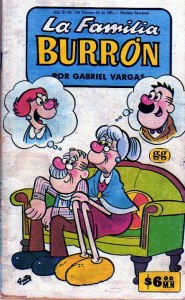 Dumb Family). Why am I starting with this one? I think a book running from 1948-2009 should be mentioned. The book was about a lower to middle-class couple in Mexico, their teenage kids, and an adopted child.1 One site mentions a comparison to The Simpsons.2 Such a success from a man who had 11 siblings and was a draftsman for a newspaper around the age of 13.
Dumb Family). Why am I starting with this one? I think a book running from 1948-2009 should be mentioned. The book was about a lower to middle-class couple in Mexico, their teenage kids, and an adopted child.1 One site mentions a comparison to The Simpsons.2 Such a success from a man who had 11 siblings and was a draftsman for a newspaper around the age of 13.
Yolanda Vargas Dulché, an author who along with Alberto  Cabreras, created her own legend and legacy with Memín Pinguín in 1943.3 Memín Pinguín was noted for its use of clean language4 with family values and handling of societal issues. Part of the societal issues handled and that were able to be addressed is that Memín and is his mother were Afro-Mexican characters. The characters in the book were based on children Yolanda had seen when she was young and had traveled.5 To be truthful, the manner in which the main character is drawn c
Cabreras, created her own legend and legacy with Memín Pinguín in 1943.3 Memín Pinguín was noted for its use of clean language4 with family values and handling of societal issues. Part of the societal issues handled and that were able to be addressed is that Memín and is his mother were Afro-Mexican characters. The characters in the book were based on children Yolanda had seen when she was young and had traveled.5 To be truthful, the manner in which the main character is drawn c onfuses me. A description has him with curly hair. But all images are of him with no hair, that I can see, and I at first thought the boy in the picture might have been Memín, but no, he’s the boy in the red shirt.
onfuses me. A description has him with curly hair. But all images are of him with no hair, that I can see, and I at first thought the boy in the picture might have been Memín, but no, he’s the boy in the red shirt.
Another of Yolanda’s creations, along with her husband Guillermo de la Parra, Lágrimas, Risas y Amor (Tears, Laughter and Love), 1962 was said to have helped to raise the literacy rate in Mexico. Think melodramas aimed at women.6
The above examples are rarities. The majority of the material that was put out during the 1970s and into the 1980s was little more than illustrated adult men’s magazine content.
Popular Books Today.
 Two books mentioned as being the most widely circulated amongst Mexico’s historietas as they are called are El Libro Vaquero (The Cowboy
Two books mentioned as being the most widely circulated amongst Mexico’s historietas as they are called are El Libro Vaquero (The Cowboy 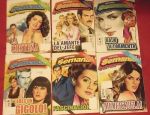 Book) aimed at men, dating back to 1952. and El Libro Semanal (The Weekly Book) aimed at women and set in the 19th century on the American frontier.7I’ll admit I like the idea of westerns as being a popular form of Graphic Literature as opposed to the normal superhero I am accustomed to.
Book) aimed at men, dating back to 1952. and El Libro Semanal (The Weekly Book) aimed at women and set in the 19th century on the American frontier.7I’ll admit I like the idea of westerns as being a popular form of Graphic Literature as opposed to the normal superhero I am accustomed to.
The Dark Ages
It has been repeatedly mentioned in the main source I’ve used about how the industry did not go through the slump the United States did during the 1990s. I’ll take a moment for a personal comment here. If American comics had resorted to selling adult men’s magazine content on cheap paper and everywhere it could, most likely they could have floated through a little better. A great many American comics are more like hard-boiled detective novels or more modern dramas. than the family-friendly fare of old.
A Family Affair.
Now let’s talk about a family with a superhero flare. Yes, I am tired of dealing with the somewhat overtly serious and direct.
I love when generations get involved in creating Graphic Literature. There are several in the United States among Marvel Comics. But we’re in Mexico.
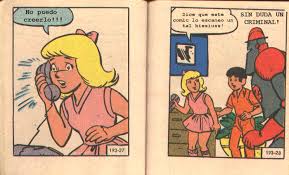 Oscar González Guerrero is not what would be called a young man these days, born in 1926 he is now 89 years young. Perhaps the medium he works in is part of what keeps him that way. He started back in the 1950s but is still active today as part of a company with his son. Some books from his early days were Zor y los Invencibles. And then one classic, I just can’t help but laugh to look at. Hermelinda Linda.8
Oscar González Guerrero is not what would be called a young man these days, born in 1926 he is now 89 years young. Perhaps the medium he works in is part of what keeps him that way. He started back in the 1950s but is still active today as part of a company with his son. Some books from his early days were Zor y los Invencibles. And then one classic, I just can’t help but laugh to look at. Hermelinda Linda.8
But let’s check out some of his son, Oscar González Loyo‘s work who  formed ¡Ka-Boom! Estudio9 with his father. Two of his noted books are Karmatron and the Transformers and Las Aventuras de Parchís. He’s also worked on titles such as the New Speed Racer, The Simpsons, and even storyboarded the Latin American version of Sesame Street. Storyboarding is where someone draws the images of how the sho
formed ¡Ka-Boom! Estudio9 with his father. Two of his noted books are Karmatron and the Transformers and Las Aventuras de Parchís. He’s also worked on titles such as the New Speed Racer, The Simpsons, and even storyboarded the Latin American version of Sesame Street. Storyboarding is where someone draws the images of how the sho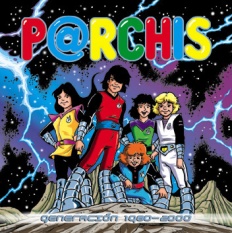 w or movie is to go. That way people can see it visually before performing. He’s also a Will Eisner award winner.10
w or movie is to go. That way people can see it visually before performing. He’s also a Will Eisner award winner.10
Well, that’s it for today. I have more but sometimes enough is enough for one day. You don’t want to know about the guy born in Mexico that ended up drawing Spider-Man and the X-Men anyway. Maybe another time. So what if the two guys above are the ones who made it happen for him.
See you tomorrow.
Let’s connect.
https://twitter.com/RonovanWrites
https://www.facebook.com/pages/Ronovan-Writes/630347477034132
https://plus.google.com/u/0/+RonovanWrites/about
© Copyright-All rights reserved by ronovanwrites.wordpress.com 2015
References
Return to Top
Return to Gabriel Vargas
1 http://en.wikipedia.org/wiki/Gabriel_Vargas
2 http://www.ualberta.ca/~berban/Mexico/mexhistory.html
Return to Yolanda Vargas Dulche
3 http://www.ualberta.ca/~berban/Mexico/mexhistory.html
4 http://en.wikipedia.org/wiki/Yolanda_Vargas_Dulch%C3%A9
5 http://en.wikipedia.org/wiki/Mem%C3%ADn_Pingu%C3%ADn
6 http://www.ualberta.ca/~berban/Mexico/mexhistory2.html
Return to Popular Today
7 http://www.ualberta.ca/~berban/Mexico/current.html
Return to Oscar Gonzales Guerrero
8 http://en.wikipedia.org/wiki/Oscar_Gonz%C3%A1lez_Guerrero
Return to Oscar Gonzalez Loyo
9 http://en.wikipedia.org/wiki/%C2%A1Ka-Boom!_Estudio
10 http://en.wikipedia.org/wiki/Oscar_Gonz%C3%A1lez_Loyo
http://en.wikipedia.org/wiki/Humberto_Ramos
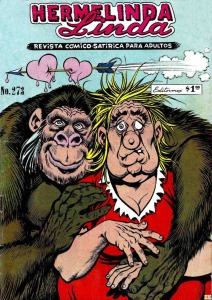


Oh, wow… For a moment, I was eight years old and standing at a Mexican newsstand buying my dad’s newspaper. I’m Mexican, and although I’ve never read a single one of these (getting my dad’s newspaper on Sunday got me an installment of La Pequeña Lulú, absent from your list–and probably deservedly so, haha), they’re ubiquitous enough to be part of the landscape–and, a few (like Hermelinda or Memín Pingüín) are pillars of Mexican pop culture… or were back when I was growing up. One of our gardeners had a few of them in his room, and I remember my mom chewing him out for leaving them in plain sight… I guess she was worried about the maids’ morals being corrupted 😉
Interesting social comment you made. Beyond pornographic content–you’ll get no dispute from me there–my main problem with these historietas is that they feed an audience of already ignorant people with more ignorance. In other words, the 50 Shades of Grey for Mexico’s poor. If you’d asked me an hour ago, I’d have sworn all these publications were long dead–and maybe they are, but if they’re not, I do wish their authors would realize the kind of power they wield–the readership on these things must be through the roof to have survived this long–and feed their audience a tad more substance with their entertainment.
Me and my soap box are off now. Sorry.
Guilie @ Quiet Laughter
LikeLiked by 2 people
Thank you so much for this. You don’t know how much it means to me to have written all the articles in this series to end up here and the Letter M in the A to Z blogging challenge to finally get a response like this. It makes all those hours of research and writing and formatting worth it. I followed you on Twitter. Love the name.
Much Respect
Ronovan
LikeLike
[…] The Big Dumb Family and The Cowboy Book. What a range. Get it? Range, cowboy. […]
LikeLike